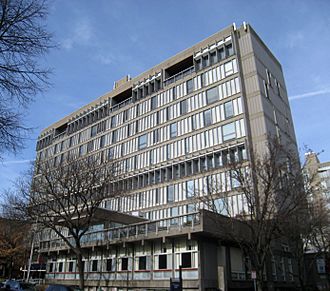Smith Campus Center facts for kids
Quick facts for kids Smith Campus Center |
|
|---|---|

South elevation, 2010
|
|
| Former names | Holyoke Center |
| General information | |
| Architectural style | Brutalist |
| Address | 1350 Massachusetts Avenue |
| Town or city | Cambridge, Massachusetts |
| Country | USA |
| Coordinates | 42°22′22″N 71°07′07″W / 42.37278°N 71.11861°W |
| Construction started | 1960 |
| Completed | 1966 |
| Owner | Harvard University |
| Height | 167 feet (51 m) |
| Technical details | |
| Floor count | 10 |
| Floor area | 360,000 sq ft (33,000 m2) |
| Design and construction | |
| Architect | José Luis Sert |
| Architecture firm | Sert, Jackson and Gourley |
The Smith Campus Center is an important building at Harvard University. It used to be called the Holyoke Center. This building is in Cambridge, Massachusetts, right across from the main entrance to Harvard Yard. It's a place where students and staff can find offices, health services, and even shops or restaurants.
Building Design and History
The Smith Campus Center was mostly designed by José Luis Sert. He was the head of the Harvard Graduate School of Design at the time. The building was finished in 1966. It is a ten-story building made of strong concrete. It has an H-shape when you look at it from above.
The building was built in two main parts. The first part started in 1960 and was ready by 1962. The second part began in 1964 and was done in 1966. There's also a nice outdoor area called Forbes Plaza. It was finished in 1967. This plaza and the shops inside were named after Edward W. Forbes to honor him.
When the first part was built, some people made jokes about its look. One joke was that the best thing about the building was that you couldn't see it from inside! Over time, the building had some problems. For example, parts of the concrete outside started to crumble. Its heating and cooling system also didn't work very well.
The Smith Campus Center was the first tall building at Harvard. Some people even called it a "gray elephant" because of its concrete color.
Art Inside the Building
For many years, from 1964 to 1979, the top floor of the building had five large paintings. These were made by a famous artist named Mark Rothko. His art style is called Abstract Expressionism.
Sadly, the sunlight coming into the room caused the paintings to fade a lot. Because of this, they were moved to a safe storage place in 1979. Since then, they have only been shown to the public a few times. The most recent time was from 2014 to 2015 at the Harvard Art Museums.
More recently, in 2018, a new artwork was added. It's called “We the People” by Danh Vō. This piece was put in during the building's big makeover. It honors Drew Gilpin Faust, who was a leader at Harvard.
New Name and Updates
The building was first known as Holyoke Center. But in 2013, it got a new name: the Richard A. and Susan F. Smith Campus Center.
After its renaming, the building went through a huge renovation. This project created many new spaces. Now, it has comfortable areas for students to gather, relax, and study. There are also spaces for art shows, special events, and performances. The newly updated building officially reopened in 2018.
See also
 In Spanish: Smith Campus Center para niños
In Spanish: Smith Campus Center para niños

